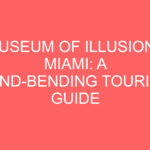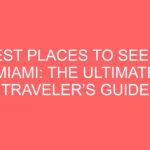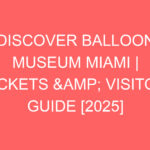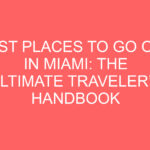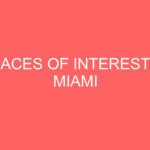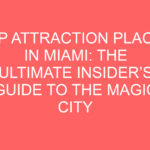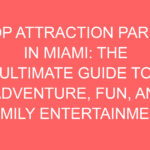Miami is a city of sun, sound, and spirit—a place where tropical beauty meets metropolitan ambition. Beyond the glittering beaches and palm-lined boulevards lies a mosaic of neighborhoods that define the city’s personality. Each district tells its own story—some alive with neon nightlife, others whispering old-world charm under banyan trees. In this comprehensive guide, we’ll explore Miami’s most iconic and emerging neighborhoods in far greater depth—unpacking what makes them special for travelers, residents, and investors alike.
🏖️ 1. Best Areas for Tourists
Miami’s tourism scene is legendary. Every area offers its own flavor—whether you crave culture, art, luxury, or just a warm breeze and turquoise sea.
🌴 South Beach (Miami Beach)
South Beach is Miami’s showstopper—a sun-soaked playground where glamour and relaxation coexist. The pastel Art Deco buildings that line Ocean Drive are postcard icons, but the neighborhood’s spirit is far more dynamic. The beach itself offers endless opportunities for fun, from jet skiing and beach volleyball to yoga and sunrise photography. When the sun sets, neon signs illuminate rooftop bars and world-famous nightclubs.
Things to Do: Lounge at Lummus Park, dine at Joe’s Stone Crab, shop at Lincoln Road Mall, enjoy a cocktail at The Betsy’s rooftop terrace, or explore the Wolfsonian-FIU Museum.
Insider Tip: The early morning golden hour offers stunning photo opportunities before the crowds arrive.
Pros: Walkable, lively nightlife, rich history, oceanfront access.
Cons: Pricey hotels, busy streets, limited parking.
🎨 Wynwood & Design District
If South Beach is the glamorous face of Miami, Wynwood is its creative soul. What was once a warehouse district has become an international art hub. Murals by Banksy, Shepard Fairey, and local artists transform walls into living canvases. Cafés double as galleries, and boutique shops sell limited-edition fashion and handmade crafts. Nearby, the Design District blends culture and couture with flagship stores from Prada, Dior, and Hermès.
Things to Do: Tour Wynwood Walls, grab craft beer at Veza Sur, browse the Institute of Contemporary Art, or enjoy rooftop dining at Swan.
Vibe: Creative, urban, constantly evolving.
Pros: Inspiring environment, perfect for photography and art lovers.
Cons: Not close to the beach, can get crowded on weekends.
🏙️ Downtown & Brickell
These neighborhoods are the financial heartbeat of Miami and a showcase of modern architecture. Brickell’s glittering towers house luxury condos, rooftop bars, and fine dining. Downtown’s bayfront attractions like PAMM and Frost Science blend business and culture. The Metromover zips between glass skyscrapers, giving visitors a free tour of the urban core.
Things to Do: Visit Brickell City Centre, enjoy a performance at the Adrienne Arsht Center, dine at Komodo, or stroll along Bayfront Park.
Vibe: Sleek, cosmopolitan, energetic.
Pros: Central location, world-class dining, luxury living.
Cons: Traffic congestion, high cost of living, limited greenery.
🇨🇺🇭🇹 Little Havana & Little Haiti
In these culturally rich neighborhoods, you experience Miami’s soul. Little Havana is filled with the rhythms of salsa and the aroma of Cuban coffee. Locals play dominoes at Máximo Gómez Park, and Calle Ocho pulses with life during the annual Carnival Miami festival. Little Haiti offers Creole art, markets, and culinary gems that reflect the city’s Caribbean heritage.
Things to Do: Visit Versailles Café, tour the Tower Theater, shop for Haitian crafts at the Caribbean Marketplace, or catch live music at Ball & Chain.
Vibe: Authentic, local, festive.
Pros: Affordable, culturally immersive, vibrant street life.
Cons: Limited hotels, older infrastructure.
🌿 Coconut Grove & Coral Gables
These areas showcase a quieter, greener Miami. Coconut Grove, the city’s oldest neighborhood, is lush with tropical vegetation and bohemian charm. Coral Gables offers architectural elegance and refined shopping. Both are ideal for travelers who prefer serenity and sophistication over crowds.
Things to Do: Explore Vizcaya Museum & Gardens, swim in the Venetian Pool, walk Miracle Mile, or have brunch under banyan trees at GreenStreet Café.
Pros: Scenic beauty, historic charm, walkable, great dining.
Cons: Expensive real estate, limited nightlife.
🏝️ Key Biscayne
Key Biscayne feels like a private paradise. Its soft beaches, nature preserves, and coastal bike trails attract families and outdoor enthusiasts. This upscale island is perfect for relaxation and luxury.
Things to Do: Visit Crandon Park, Bill Baggs State Park, or the Miami Seaquarium.
Pros: Family-friendly, peaceful, surrounded by nature.
Cons: Expensive, limited entertainment options.
🏡 2. Best Areas to Live in Miami
👨👩👧👦 For Families
Miami’s family neighborhoods blend safety, education, and community. Pinecrest leads the list with top schools and spacious homes. Palmetto Bay offers suburban tranquility with affordable options. Coral Gables and Coconut Grove provide excellent public and private schools alongside family-friendly parks and cultural events.
Community Perks: Family farmers’ markets, weekend art fairs, and clean parks foster connection.
Pros: Secure, community-oriented, green surroundings.
Cons: High property prices, slower nightlife.
💼 For Young Professionals
Young professionals thrive in fast-paced areas like Brickell, Downtown, Edgewater, and Wynwood. These neighborhoods are walkable, filled with coworking spaces, and close to nightlife. The vibe is modern, social, and tech-forward.
Perks: Networking events, rooftop gyms, proximity to major employers.
Pros: Trendy, convenient, cosmopolitan.
Cons: High rent, heavy traffic.
🌅 For Retirees
Retirees find peace and luxury in Aventura, Bal Harbour, Sunny Isles, and Surfside. These coastal areas offer safe, scenic environments and world-class amenities. Golf courses, art centers, and beachfront promenades create an ideal retirement setting.
Highlights: Bal Harbour Shops, Turnberry Isle Golf Course, and Surfside’s beachfront trail.
Pros: Safe, relaxed, senior-friendly.
Cons: High living costs, quieter pace.
💰 3. Best Areas for Real Estate Investment
🏢 Brickell & Downtown
High-rise condos with bay views dominate these markets. Rental yields remain strong, averaging 6–8% annually, with luxury projects like Baccarat Residences and Aston Martin Tower promising long-term appreciation. Infrastructure upgrades and tech startups are fueling continued demand.
Why Invest: Business hub, transit access, strong rental market.
Challenges: Pricey entry point, dense competition.
🏖️ South Beach (SoFi)
Exclusive and always in demand, SoFi’s condos and boutique hotels offer year-round rental potential. Renovated Art Deco buildings maintain high occupancy from international tourists.
Why Invest: Timeless appeal, strong brand recognition, high resale value.
Challenges: Short-term rental regulations, management costs.
🎨 Wynwood & Little Haiti
These are Miami’s creative investment frontiers. Affordable entry prices and rapid transformation make them ideal for forward-thinking investors. Co-living spaces and small boutique apartments cater to young tenants.
Why Invest: Emerging demand, cultural credibility, rapid development.
Challenges: Infrastructure improvements still underway.
🌿 Coral Gables & Key Biscayne
These markets attract long-term buyers seeking prestige and stability. Coral Gables’ Mediterranean estates and Key Biscayne’s oceanfront villas are considered blue-chip assets.
Why Invest: Consistent appreciation, limited land supply, low volatility.
Challenges: Very high entry cost, restrictive zoning.
🏗️ Bonus Hotspots
- Edgewater: Waterfront condos and proximity to Wynwood make it a rising luxury hub.
- Aventura: Blending commercial and residential growth, supported by top schools and shopping centers.
- Little River: Rapidly growing creative community with affordable plots for redevelopment.
Investment Tip: Diversify—pair luxury rentals in South Beach with value-growth opportunities in Wynwood or Little River.
💸 4. Most Affordable Neighborhoods
🏡 Gladeview
Affordable, diverse, and well-located, Gladeview offers suburban calm near the city center. Residents enjoy easy access to downtown, parks, and shopping. Home values are rising steadily as revitalization projects continue.
Highlights: Gwen Cherry Park, new community programs, affordable ownership options.
Pros: Low prices, growing demand, convenient commute.
Cons: Limited nightlife, small commercial district.
🌳 Westchester
Known for wide streets and mid-century homes, Westchester offers suburban stability. Family-run Cuban restaurants, parks, and proximity to major highways make it one of Miami’s most livable affordable areas.
Highlights: Tropical Park, Coral Way shopping, cultural eateries.
Pros: Family-oriented, great schools, strong community.
Cons: Older infrastructure, distance from beaches.
🐠 South Miami Heights
Close to Zoo Miami and Southland Mall, this neighborhood combines affordability with outdoor charm. Families enjoy large yards and low HOA fees. Developers are adding schools and supermarkets, signaling growth potential.
Highlights: Nature trails, affordable new builds, family-oriented design.
Pros: Affordable, peaceful, family-friendly.
Cons: Commute to city center can be long.
✈️ Flagami
Flagami’s location between downtown and the airport makes it a top choice for professionals. Its cultural diversity and affordable rents draw a steady influx of residents. Small cafés, shops, and parks add neighborhood character.
Highlights: Magic City Casino, Grapeland Water Park, quick access to highways.
Pros: Central, affordable, improving amenities.
Cons: Airport noise, aging infrastructure.
Why Choose These Areas: Each offers affordability without isolation. They’re practical for first-time homeowners, students, and workers who value convenience and culture.
🌇 5. Hidden Gems & Up-and-Coming Areas
🏙️ Allapattah
Located west of Wynwood, Allapattah is quietly emerging as Miami’s new creative quarter. Old warehouses are turning into art studios, breweries, and loft apartments. The Rubell Museum has fueled the area’s transformation.
Highlights: Art venues, affordable warehouse conversions, central location.
Investment Potential: High for early buyers; prices rising steadily.
🌴 Little River
Little River is an affordable alternative to Wynwood, favored by entrepreneurs and small studios. Its industrial buildings are being repurposed into trendy cafés and offices, attracting a creative crowd.
Highlights: Maker spaces, community events, and proximity to Biscayne Boulevard.
Investment Potential: Moderate to high; excellent long-term growth.
🏡 El Portal
El Portal’s tree-lined streets and riverside homes attract buyers seeking tranquility with city access. It’s small but growing fast, with property values climbing as nearby areas gentrify.
Highlights: Quiet streets, nature reserves, proximity to Design District.
Investment Potential: Strong for families and remote workers seeking value.
🌞 Final Thoughts
Miami is more than beaches and nightlife—it’s a city of opportunities woven into a tropical dreamscape. From the Art Deco allure of South Beach to the artistic rebellion of Wynwood and the timeless charm of Coral Gables, every neighborhood adds a new note to the city’s melody. Whether you’re visiting for a few days or planting roots for a lifetime, Miami offers a rhythm, color, and community for everyone. 🌴✨

